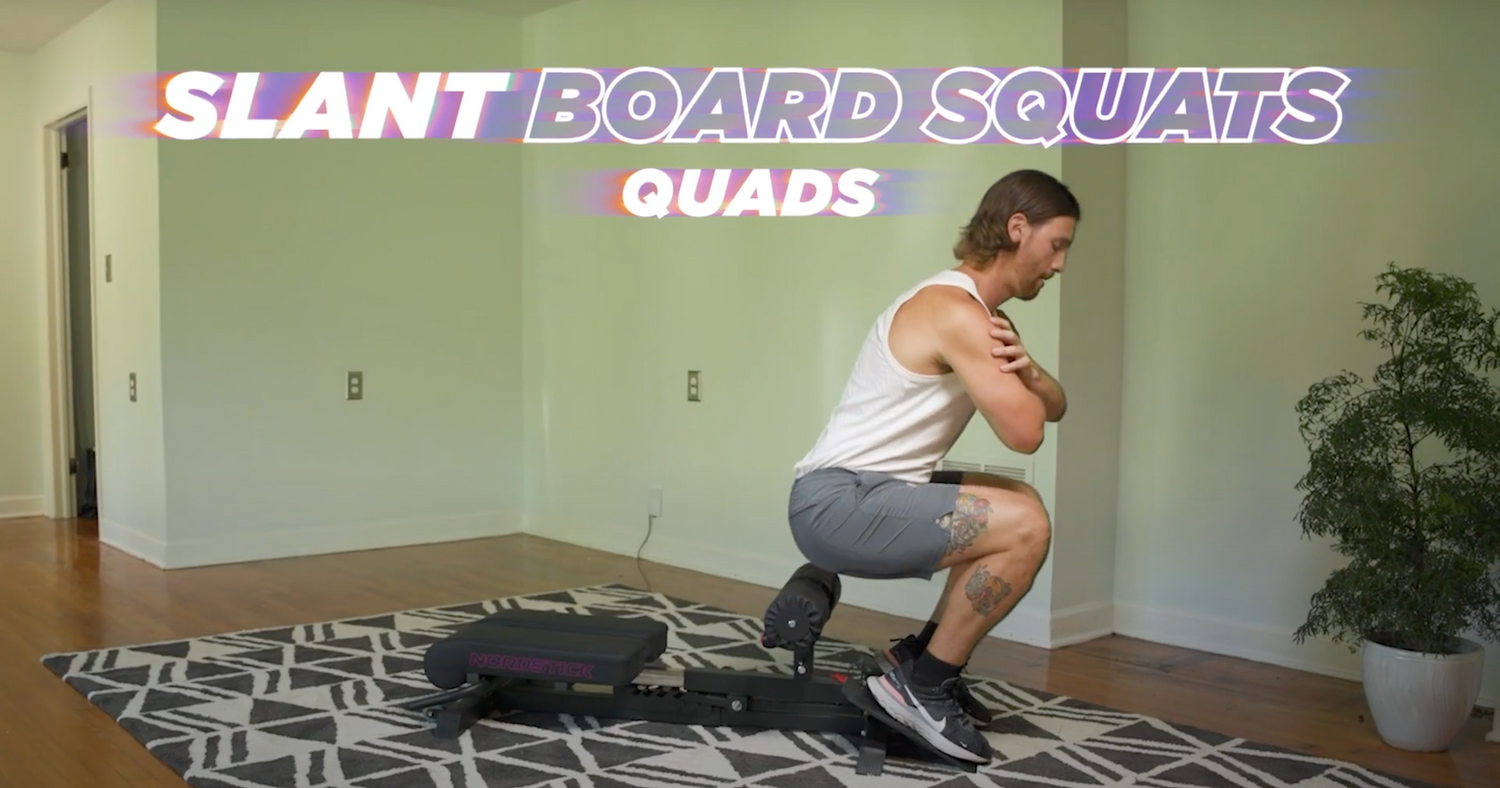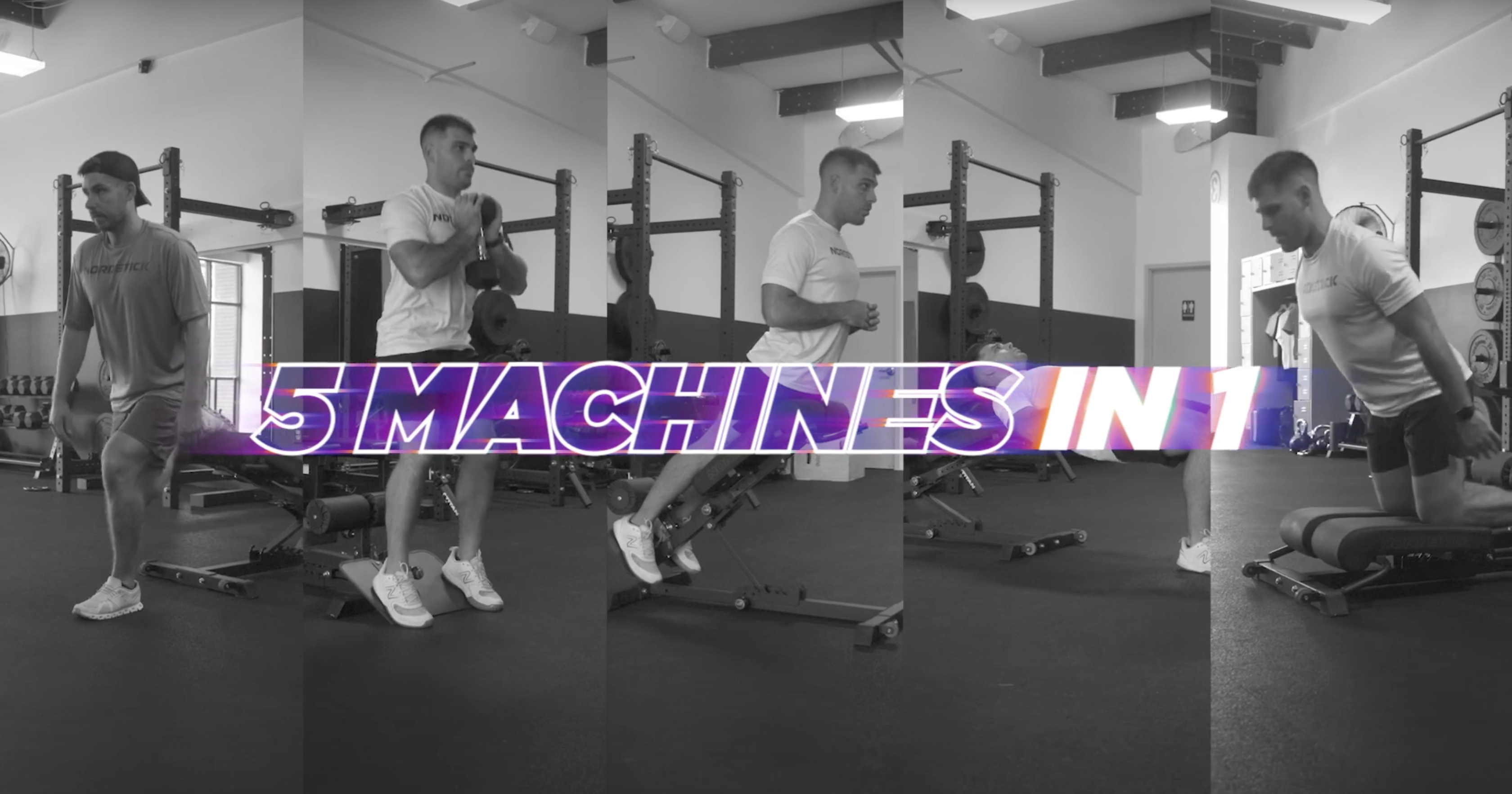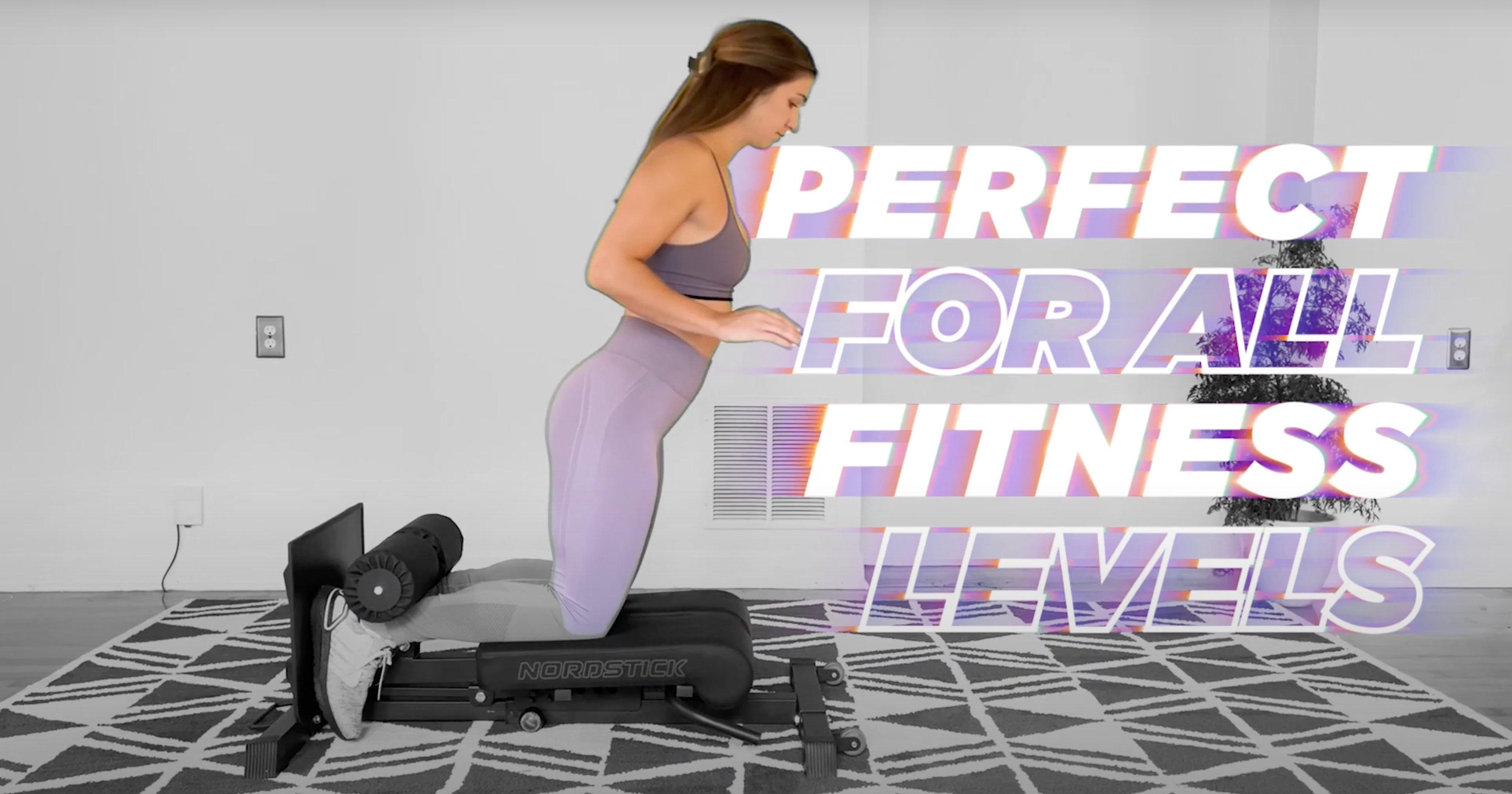The NordBench offers a versatile and effective solution for anyone looking to strengthen and sculpt their body from the comfort of their home. Whether you're a performance-driven athlete, a fitness enthusiast, or someone committed to lifelong activity, the NordBench can help you reach your goals with its diverse range of exercises.
In this blog, we'll dive into five must-do NordBench exercises that target key muscle groups and enhance overall strength and functionality. Get ready to empower yourself with these essential exercises that make the most of the NordBench's unique features and adaptability.
Nordic Curls

Benefits of Nordic Curls
Nordic curls are a powerful exercise primarily targeting the hamstrings. This movement significantly strengthens the hamstrings, which can help reduce the risk of injuries, especially for athletes.
Enhanced hamstring strength also contributes to better sprint speed, making it a favored exercise among runners and sprinters. The NordBench offers eight levels of regression, making it accessible for all fitness levels—whether you're a beginner or an advanced athlete.
By incorporating Nordic curls into your routine, you can improve your overall lower body strength and stabilize your knee joints, which is crucial for both athletic performance and everyday activities. This exercise also engages your core and glutes, providing a comprehensive workout that enhances your functional fitness.
Adjusting Difficulty Levels

One of the standout features of the NordBench is its ability to adjust difficulty levels for Nordic curls. With eight levels of regression, this bench can accommodate users at any fitness level.
Beginners can start with higher levels of assistance, gradually reducing the support as their strength improves. This progression allows you to build up your hamstring strength safely and effectively.
Advanced users can challenge themselves by minimizing assistance, increasing the intensity of their workouts. This flexibility ensures that you can continually progress and avoid hitting a plateau in your training.
Adjusting the difficulty levels is straightforward, making it easy to customize your workouts according to your current capabilities and fitness goals. This adaptability not only enhances the effectiveness of the Nordic curls but also ensures that you can use the NordBench for long-term fitness progression.
Back Extensions

Perfecting the Angles
Back extensions on the NordBench can be performed at various angles to target different muscle groups effectively. When set at a 45-degree angle, the exercise emphasizes the hamstrings, glutes, and lower back, providing a comprehensive workout for the posterior chain.
Adjusting the angle to 30 degrees shifts the focus slightly more towards the glutes and lumbar extensors, making it ideal for those looking to enhance their core and lower back strength. For a more intense core and glute engagement, you can incorporate isometric holds at 0 degrees.
This variation challenges your muscles to maintain stability and improves endurance. By perfecting these angles, you can ensure a balanced and effective workout, tailored to your specific fitness needs. The versatility in angles not only helps in muscle targeting but also in preventing workout monotony, keeping your routine engaging and dynamic.
Isometric Holds Explained
Isometric holds in back extensions involve maintaining a static position to engage and strengthen muscles without movement. When performed on the NordBench at a 0-degree angle, these holds primarily target the glutes and lumbar extensors.
This type of exercise is particularly beneficial for improving muscular endurance and stability. By holding the position, you create continuous tension in the muscles, which enhances their strength and resilience.
Isometric holds are also excellent for improving posture and core stability, as they require the engagement of multiple muscle groups simultaneously to maintain the hold. This exercise can be particularly useful for those recovering from lower back injuries, as it strengthens the supportive muscles without excessive strain.
Incorporating isometric holds into your back extension routine can add variety and significantly boost your overall core and back strength.
Targeting Different Muscle Groups
Back extensions on the NordBench are highly effective in targeting various muscle groups depending on the angle used.
At a 45-degree angle, the exercise predominantly engages the hamstrings, glutes, and lower back. This angle is ideal for those looking to strengthen their entire posterior chain, which is essential for activities like lifting and running.
Shifting the angle to 30 degrees slightly reduces hamstring engagement but increases the focus on the glutes and lumbar spine. This variation is beneficial for those aiming to enhance their core and lower back strength.
Additionally, incorporating isometric holds at 0 degrees specifically targets the glutes and lumbar extensors, providing a different kind of muscle activation that improves stability and endurance. By adjusting the angles, you can ensure a comprehensive workout that addresses multiple muscle groups, making your back extension routine both versatile and highly effective.
Hip Thrusts

Proper Form and Technique
Maintaining proper form and technique during hip thrusts is crucial for maximizing benefits and reducing injury risk. Begin by positioning your upper back against the NordBench, with your feet flat on the ground and knees bent at a 90-degree angle. Your shoulders should be firmly supported by the bench.
As you initiate the thrust, drive through your heels and lift your hips towards the ceiling, ensuring your body forms a straight line from your shoulders to your knees. At the top of the movement, squeeze your glutes and hold for a brief moment before lowering your hips back to the starting position.
Keep your core engaged throughout the exercise to maintain stability and prevent lower back strain. Avoid overarching your back or letting your knees cave in, as these mistakes can lead to injury. Practicing proper form ensures that you effectively target the glutes, hamstrings, and lower back, enhancing your overall lower body strength.
Benefits for Athletic Performance
Hip thrusts are a cornerstone exercise for enhancing athletic performance. This movement primarily targets the glutes, which play a crucial role in generating power and stability in many sports activities.
Strong glutes contribute to better sprint speed, improved jumping ability, and enhanced overall lower body strength.
Additionally, hip thrusts engage the hamstrings and lower back, making them a comprehensive exercise for the posterior chain. This is particularly beneficial for athletes who require explosive power and endurance.
By incorporating hip thrusts into your training regimen, you can improve your ability to accelerate, decelerate, and change directions quickly. These gains translate to better performance on the field, court, or track.
Furthermore, strong glutes and a stable core help reduce the risk of injuries, particularly in the lower back and knees, allowing athletes to perform at their best consistently.
Integrating Hip Thrusts into Your Routine
Integrating hip thrusts into your workout routine can significantly enhance your overall strength and athletic performance.
Begin by incorporating them into your leg or lower body days, ideally after compound movements like squats or deadlifts when your muscles are already warmed up. Aim for 3 to 4 sets of 8 to 12 repetitions, focusing on maintaining proper form throughout each repetition. You can increase the intensity by adding resistance through weights or bands.
Hip thrusts can also be paired with other glute-focused exercises, such as lunges or glute bridges, for a comprehensive lower-body workout. Additionally, consider integrating them into a circuit training routine to enhance muscular endurance and cardiovascular fitness simultaneously.
By consistently incorporating hip thrusts into your routine, you can achieve balanced muscle development, reduce injury risk, and boost your overall athletic performance. Remember, consistency and proper form are key to reaping the full benefits of this powerful exercise.
Split Squats

Sport-Specific Benefits
Split squats offer numerous sport-specific benefits that make them an essential part of any athlete's training regimen.
This single-leg exercise enhances balance, coordination, and unilateral leg strength, which are crucial for sports that require quick changes in direction, such as basketball, soccer, and tennis.
By focusing on one leg at a time, split squats can help correct muscle imbalances and improve overall stability. This leads to better performance and a reduced risk of injuries. The movement also targets key muscle groups like the quadriceps, hamstrings, and glutes, which are essential for powerful sprints and jumps.
Additionally, the enhanced proprioception from split squats aids in better body awareness and control during complex movements. For runners, this exercise can improve stride efficiency and reduce the likelihood of lower limb injurie. Overall, integrating split squats into your training routine can provide sport-specific strength and stability, translating to improved athletic performance.

Everyday Benefits
Split squats are not only beneficial for athletes but also offer significant advantages for everyday life. This exercise enhances unilateral leg strength, improving balance and coordination, which are essential for daily activities like walking, climbing stairs, and carrying heavy objects.
By strengthening the quadriceps, hamstrings, and glutes, split squats contribute to better lower body stability, reducing the risk of falls and injuries. Additionally, the improved muscle balance from performing split squats can alleviate common issues like knee pain and lower back discomfort.
This exercise also promotes joint health by improving mobility and flexibility in the hips and knees. For those who spend long hours sitting, split squats can counteract the negative effects of prolonged inactivity by activating and strengthening key muscle groups.
Integrating split squats into your fitness routine can lead to enhanced functional strength, making everyday tasks easier and more manageable.

How to Perform

To perform a split squat correctly, start by standing with one foot elevated behind you on the NordBench and the other foot firmly planted on the ground. Your front foot should be far enough forward so that when you lower into the squat, your knee stays in line with your ankle.
Begin the movement by lowering your hips towards the floor, bending both knees to about a 90-degree angle. Ensure your torso remains upright and your core is engaged throughout the exercise.
Push through the heel of your front foot to return to the starting position. Keep your movements controlled to maintain balance and proper form. Aim for 3 to 4 sets of 8 to 12 repetitions on each leg, adjusting the difficulty by adding weights or resistance bands as needed.
Performing split squats with proper technique will maximize their benefits, enhancing strength, stability, and muscle balance.
Slant Board Squats

Why This Exercise is a Must
Slant board squats are a must-have in any fitness routine due to their unique benefits. Elevating your heels on a slant board increases quadriceps activation, allowing for a deeper squat and more effective targeting of the thigh muscles.
This variation is particularly beneficial for those with limited ankle mobility, as it helps achieve proper squat depth without compromising form. Enhanced quad activation and deeper squats translate to greater muscle development and strength gains. Additionally, slant board squats improve overall squat technique by promoting better posture and alignment.
This exercise also reduces the stress on the lower back and knees, making it a safer option for individuals with joint concerns. Incorporating slant board squats into your workout routine can enhance your lower body strength, improve mobility, and support overall functional fitness.
How to Perform
To perform slant board squats, start by positioning your heels on the adjustable slant board of the NordBench. Your feet should be shoulder-width apart, with toes slightly pointed outwards.
Engage your core and maintain an upright torso as you begin to lower your body into a squat. Bend your knees and hips simultaneously, allowing your knees to track over your toes while keeping your weight distributed evenly on your feet.
Descend until your thighs are parallel to the floor or as low as your mobility allows. Push through your heels to return to the starting position, making sure to keep your back straight and chest up throughout the movement. Aim for 3 to 4 sets of 8 to 12 repetitions, adjusting the angle of the slant board to match your comfort and mobility levels.
Performing slant board squats with proper form ensures you maximize the benefits while minimizing the risk of injury.
Conclusion
The NordBench proves to be an invaluable addition to any home workout routine, offering a compact and versatile solution for full-body strength training. From Nordic curls to slant board squats, this equipment enables you to target key muscle groups effectively, enhancing overall strength, stability, and functionality.
Whether you are an athlete aiming to boost performance or someone looking to improve daily activities, these exercises provide substantial benefits. The ability to adjust difficulty levels and angles ensures that your workouts are tailored to your fitness level and goals.
By incorporating these must-do NordBench workouts into your routine, you can achieve a well-rounded fitness regime that promotes long-term health and vitality. So, set up your NordBench, follow the proper techniques, and start experiencing the transformative effects of these essential exercises today.









































Leave a comment
This site is protected by hCaptcha and the hCaptcha Privacy Policy and Terms of Service apply.